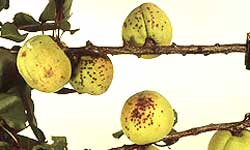Stone fruit scab (or freckle)
Scab or freckle is a fungal disease of stone fruit caused by Venturia carpophila (anamorph Fusicladium carpophilum = Cladosporium carpophilum). The disease is found worldwide, especially in warm, wetter areas.
It affects most stone fruit, including plums, but in Victoria is most important on:
- mid-season and late-season peaches and nectarines
- apricot
- almond.
Scab can cause defoliation and scabbing of fruit, which may cause loss or downgrading of fruit quality.
It is more severe in southern Victoria. A related fungus, Venturia cerasi, has been reported on cherries overseas, but it's not known whether this pathogen occurs in Australia.
Symptoms of scab
Scab can affect:
- fruit
- leaves
- twigs.
On fruits:
- It first appears on fruits as small dark spots about 6 to 8 weeks after petal fall.
- On mature fruits, the fungus forms small, circular, sooty-brown spots or freckles that become scabby (Figure 1).
- These can merge to form large, irregular dark brown lesions.
- When infection is severe, the fruit can crack, shrivel and fall prematurely.
- On apricot fruit, scab lesions are pale green and remain flush with the fruit surface. This is different to shot-hole disease, which causes raised scabs on the fruit surface of apricots.
- On peaches, lesions are flat, circular black spots up to 3mm in diameter.
- On nectarines, the skin loses its pigment and becomes pale green to cream in colour. The centre of each spot is dark with the development of spores.

On leaves, infections appear as:
- sooty or olive blotches on the underside of leaves
- dark lesions running along the mid-rib and petiole.
Severe leaf infection can cause defoliation, but in some cases, little or no leaf infection can be found even when the fruit is badly affected.
On the twigs:
- small brown lesions with slightly raised margins might appear (Figure 2)
- the margins of lesions might become olivaceous where the pathogen is sporulating.

Life cycle
The pathogen overwinters on twig lesions, and spores are blown or splashed onto developing fruits, leaves and shoots.
Infections are most severe during wet weather in spring and summer. There is a long incubation period of around 45 days before symptoms are seen.
The fungus can also overwinter in infected leaves that fall to the ground in autumn, though the significance of this is not known.
Controlling scab
The following tips can help control the spread of scab in stone fruits:
- The disease can be controlled by sprays of suitable fungicides at shuck fall (the time when dried floral remains fall from the developing fruitlet) and again 7 to 8 weeks later.
- You can also help reduce the potential carry-over of the disease by pruning out infected shoots.
- Avoid overhead irrigation and maintain an open tree canopy, as these practices will reduce the time that tree parts remain wet and will assist scab control.
Reporting an unusual plant insect pest or disease
Report any unusual plant pest or disease immediately using our online reporting form or by calling the Exotic Plant Pest Hotline on 1800 084 881. Early reporting increases the chance of effective control and eradication.
Please take multiple good quality photos of the pests or damage to include in your report where possible, as this is essential for rapid pest and disease diagnosis and response.
Your report will be responded to by an experienced staff member, who may seek more information about the detection and explain next steps.
Report onlinePhoto credits
Figure 2 courtesy of Clemson University - USDA Cooperative Extension Slide Series, Bugwood.org